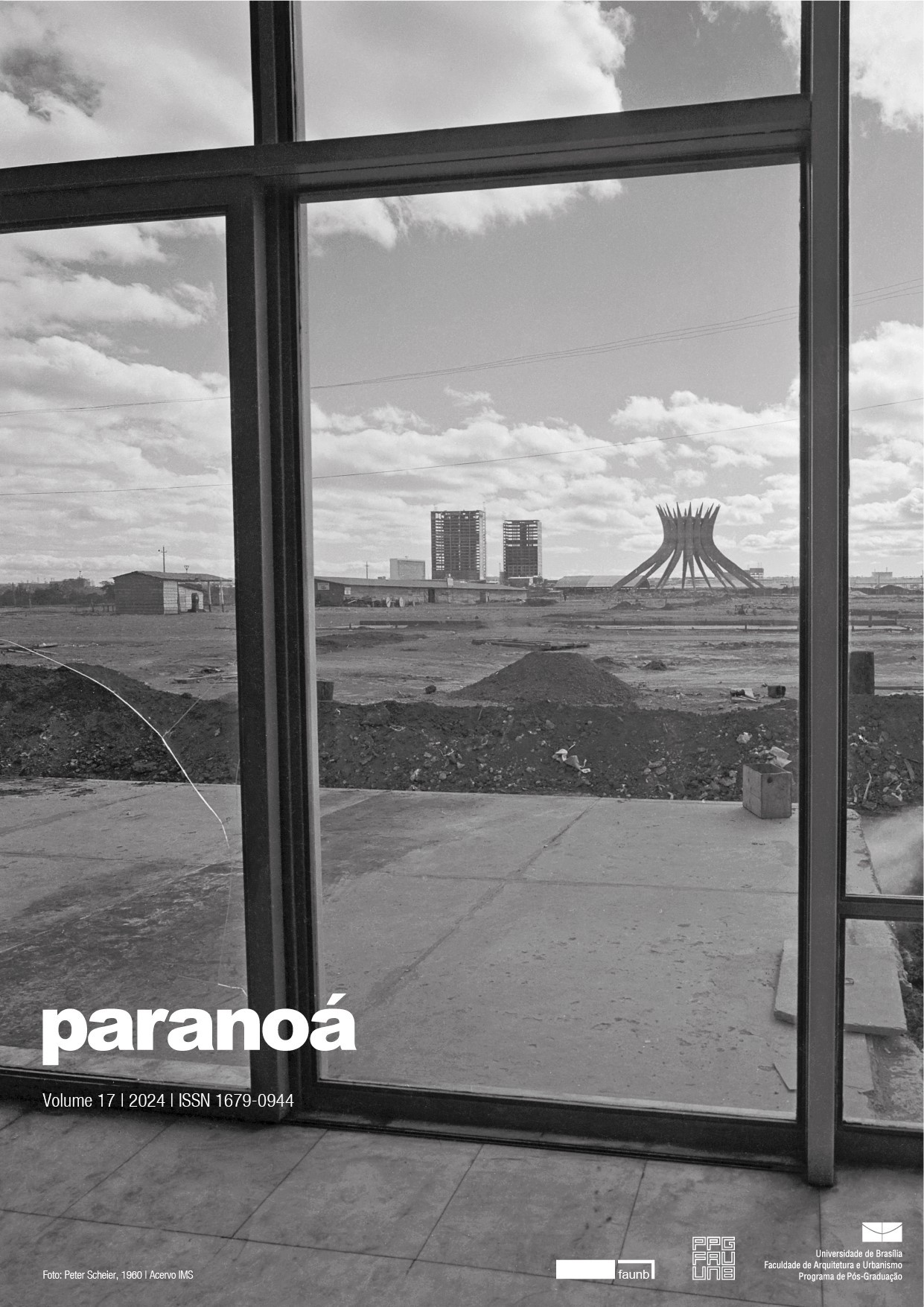Invisible favelas
the cartographic production of Rio de Janeiro and the representation of its favelas
DOI:
https://doi.org/10.18830/1679-09442024v17e51377Keywords:
Favelas, Cartography, Rio de JaneiroAbstract
This article presents the first part of the results of a study on the presence and/ or absence of Rio de Janeiro’s favelas in the city’s cartography. Different data sources were used: research in the municipal archives—including the Rio’s first aerial photographs ever made, cartographic records and infrastructure maps from the 1920s and 1930s; research in building codes; and research on digital cartographic platforms. The aim of the article is to investigate when and how the urban phenomenon of favelas officially appears in the city’s records and to reflect on how this late and inconsistent recognition may have affected the existence of the phenomenon itself, since its lack of official recognition created bureaucratic barriers to public administration actions. The argument of this article is that cartographic production has kept the favela an invisible part of the city and how, especially in recent decades, this invisibility has been a political choice. The article concludes that the choice for invisibility has contributed to these large territories becoming deeply embedded in the city’s urban fabric.
Downloads
References
ANTUNES, Laura. Google Maps faz do Rio um aglomerado de favelas. Extra – O Globo, Rio de Janeiro, April 23, 2011a. Retrieved October 6, 2024, from http://extra.globo.com/noticias/rio/google-maps-faz-do-rio-um-aglomerado-de-favelas-1655882.html.
ANTUNES, Laura. Google modificará seus mapas sobre o Rio. O Globo Rio, Rio de Janeiro, April 25, 2011b. Retrieved October 6, 2024, from http://oglobo.globo.com/rio/google-modificara-seus-mapas-sobre-rio-2791639.
AZEVEDO, Patrícia; SANTOS, Natalia. Wikimapa: a voz do morro. MundoGEO, São Paulo, May 15, 2010. Retrieved October 6, 2024, from http://mundogeo.com/blog/2010/05/14/wikimapa-a-voz-do-morro/.
BBC News. Google to amend Rio maps over Brazil favela complaints. BBC News, [S.l.], April 26, 2011. Retrieved October 7, 2024, from http://www.bbc.co.uk/news/world-latin-america-13193503.
BERENSTEIN JACQUES, Paola. Estética da ginga: a arquitetura das favelas através da obra de Hélio Oiticica. Rio de Janeiro: Casa da Palavra, 2001.
BOWATER, Donna. Google “removes word favela” from Rio maps. The Telegraph, London, April 9, 2013. Retrieved October 7, 2024, from https://www.telegraph.co.uk/technology/google/9982153/Google-removes-word-favela-from-Rio-maps.html.
DUARTE, Gabriel Nogueira. Maps to hack, synchronise and decipher: unseen cartographies of Rio. Architectural Design, London, v. 86, n. 3, p. 48-53, May/ June 2016. Retrieved October 7, 2024, from https://onlinelibrary.wiley.com/doi/abs/10.1002/ad.2045.
YAPP, Robin. Google accused of representing Rio de Janeiro as ‘mass of favelas’. The Telegraph, London, April 26, 2011. Retrieved October 7, 2024, from http://www.telegraph.co.uk/technology/google/8472462/Google-accused-of-representing-Rio-de-Janeiro-as-mass-of-favelas.html.
JOHANSON, Mark. Why Rio’s ‘favelas’ disappeared on Google Maps. International Business Times, New York, April 11, 2013. Retrieved October 7, 2024, from http://www.ibtimes.com/why-rios-favelas-disappeared-google-maps-1185455.
KORIAKINE, Alexandre; SAVELIEV, Evgeniy. WikiMapia – Vamos Descrever o Mundo Todo!. Retrieved October 7, 2024, from http://wikimapia.org.
PREFEITURA DO DISTRITO FEDERAL. Código de Obras do Distrito Federal. Decreto nº 6.000, de 1 de julho de 1937. Revista Municipal de Engenharia, Rio de Janeiro, [1937]. Retrieved October 7, 2024, from https://www.rio.rj.gov.br/dlstatic/10112/4868406/4128397/codigo_obras_1937_parte_1.pdf.
REDE JOVEM. Wikimapa 2014. SlideShare, [2014]. Retrieved October 7, 2024, from https://pt.slideshare.net/redejovem/wikimapa-2014-engfinal.
SAMPAYO, Mafalda Teixeira de; MARAT-MENDES Teresa. Análise e avaliação dos arquivos de cartografia urbana em Lisboa no estudo da forma urbana. ISCTE-IUL, 2013, 7–10.
SILVA, Maria Lais Pereira da; PAULA, Tainá Reis de. Iconografia Das Favelas Cariocas: Uma História de Omissão e de Recuperação. In: ENCONTRO NACIONAL DA ASSOCIAÇÃO NACIONAL DE PÓS-GRADUAÇÃO E PESQUISA EM PLANEJAMENTO URBANO E REGIONAL, 11., 2005, Salvador, Anais [...]. Salvador: ANPUR, 2005.
STURM, Heloisa Aruth. Favelas desaparecem de busca no Google Maps. Estadão, São Paulo, April 4, 2013. Retrieved October 15, 2024, from https://www.estadao.com.br/brasil/favelas-desaparecem-de-busca-no-google-maps/.
TÁ NO MAPA. [S.l.]: 2013. Retrieved May 17, 2015, from http://www.tanomapa.org/.
VALLADARES, Licia do Prado. A invenção da favela: do mito de origem a favela.com. Rio de Janeiro: Fundação Getúlio Vargas Editora, 2005.
VENTURA, Felipe. Google “desfavelizou” Rio de Janeiro no Google Maps?. Gizmodo - UOL, [S.l.], April 9, 2013. Retrieved October 7, 2024, from https://gizmodo.uol.com.br/google-desfavelizou-rio-de-janeiro-no-google-maps/.
Downloads
Published
How to Cite
Issue
Section
License
Copyright (c) 2024 Paranoá

This work is licensed under a Creative Commons Attribution 4.0 International License.
Autores que publicam nesta revista concordam com os seguintes termos:
- Autores mantém os direitos autorais e concedem à revista o direito de primeira publicação, com o trabalho simultaneamente licenciado sob a Licença Creative Commons Attribution que permite o compartilhamento do trabalho com reconhecimento da autoria e publicação inicial nesta revista. http://creativecommons.org/licenses/by/4.0
- Autores têm autorização para assumir contratos adicionais separadamente, para distribuição não-exclusiva da versão do trabalho publicada nesta revista (ex.: publicar em repositório institucional ou como capítulo de livro), com reconhecimento de autoria e publicação inicial nesta revista.
- Autores têm permissão e são estimulados a publicar e distribuir seu trabalho online (ex.: em repositórios institucionais ou na sua página pessoal) a qualquer ponto antes ou durante o processo editorial, já que isso pode gerar alterações produtivas, bem como aumentar o impacto e a citação do trabalho publicado (Veja O Efeito do Acesso Livre).















